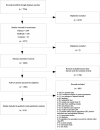Case fatality risk of diarrhoeal pathogens: a systematic review and meta-analysis
- PMID: 35578827
- PMCID: PMC9557849
- DOI: 10.1093/ije/dyac098
Case fatality risk of diarrhoeal pathogens: a systematic review and meta-analysis
Abstract
Background: Estimates of the relative contribution of different pathogens to all-cause diarrhoea mortality are needed to inform global diarrhoea burden models and prioritize interventions. We aimed to investigate and estimate heterogeneity in the case fatality risk (CFR) of different diarrhoeal pathogens.
Methods: We conducted a systematic review and meta-analysis of studies that reported cases and deaths for 15 enteric pathogens published between 1990 and 2019. The primary outcome was the pathogen-specific CFR stratified by age group, country-specific under-5 mortality rate, setting, study year and rotavirus vaccine introduction status. We developed fixed-effects and multilevel mixed-effects logistic regression models to estimate the pooled CFR overall and for each pathogen, controlling for potential predictors of heterogeneity.
Results: A total of 416 studies met review criteria and were included in the analysis. The overall crude CFR for all pathogens was 0.65%, but there was considerable heterogeneity between and within studies. The overall CFR estimated from a random-effects model was 0.04% (95% CI: 0.026%-0.062%), whereas the pathogen-specific CFR estimates ranged from 0% to 2.7%. When pathogens were included as predictors of the CFR in the overall model, the highest and lowest odds ratios were found for enteropathogenic Escherichia coli (EPEC) [odds ratio (OR) = 3.0, 95% CI: 1.28-7.07] and rotavirus (OR = 0.23, 95% CI: 0.13-0.39), respectively.
Conclusion: We provide comprehensive estimates of the CFR across different diarrhoeal pathogens and highlight pathogens for which more studies are needed. The results motivate the need for diarrhoeal interventions and could help prioritize pathogens for vaccine development.
Keywords: Case fatality ratio; death; diarrhoea; heterogeneity; mortality.
© The Author(s) 2022. Published by Oxford University Press on behalf of the International Epidemiological Association.
Figures





References
-
- Wang H, Naghavi M, Allen C et al. GBD 2015 Mortality and Causes of Death Collaborators. Global, regional, and national life expectancy, all-cause mortality, and cause-specific mortality for 249 causes of death, 1980-2015: a systematic analysis for the Global Burden of Disease Study 2015. Lancet 2016;388:1459–544. - PMC - PubMed
-
- Walker CF, Black RE. Diarrhoea morbidity and mortality in older children, adolescents, and adults. Epidemiol Infect 2010;138:1215–26. - PubMed
Publication types
MeSH terms
Substances
Grants and funding
LinkOut - more resources
Full Text Sources
Miscellaneous

